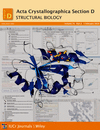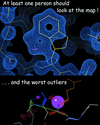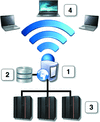issue contents
February 2018 issue
From crystal to structure with CCP4 (Part 1)
Proceedings of the CCP4 Study Weekend edited by Charles Ballard, Mike Hough and Keith Wilson

introduction
Open  access
access
 access
accessAn introduction to the 2017 CCP4 Study Weekend Special Issue.
research papers
Open  access
access
 access
accessCCP4i2 is a graphical user interface to the CCP4 (Collaborative Computational Project, Number 4) software suite and a Python language framework for software automation.
Open  access
access
 access
accessA new X-ray diffraction data-analysis package is presented with a description of the algorithms and examples of its application to biological and chemical crystallography.
Open  access
access
 access
accessLikelihood-based SAD substructure determination can be initiated using a fast translation-search algorithm based on a linear approximation to the SAD likelihood target, followed by log-likelihood-gradient map completion.
Open  access
access
 access
accessExperimental phasing of macromolecular crystals is described and explained, with the emphasis on its implementation in the programs SHELXC, SHELXD and SHELXE, which are also used in a number of macromolecular structure-solution pipelines.
Open  access
access
 access
accessThe relaxed averaged alternating reflections (RAAR) phase-retrieval method has been applied to crystallography for the first time and has been shown to outperform charge flipping in anomalous substructure determination.
Open  access
access
 access
accessA method is described for the refinement of an electron-density model against a set of structure-factor observations which does not rely on atomic parameters. The effective level of detail in the parameterization can be varied to ensure that the refinement is well determined at any resolution supported by the data.
Open  access
access
 access
accessAn overview is provided of current crystallographic model validation of proteins and RNA, both foundations and criteria, at all resolution ranges, together with advice on how to correct specific types of problems and when you should not try so hard that you are overfitting.
Open  access
access
 access
accessThe paper describes recent CCP4 initiatives and projects aimed at bringing software and data services which utilize distributed computational resources to users.
Open  access
access
 access
accessMacromolecular crystallography has provided results that underpin much biological discovery and there is still scope for further development; however, a revolution in electron imaging now means that it can also routinely provide detailed atomic-level descriptions. This article attempts to tease out where crystallography is going and consider what its place might be in the new landscape.


 journal menu
journal menu

























